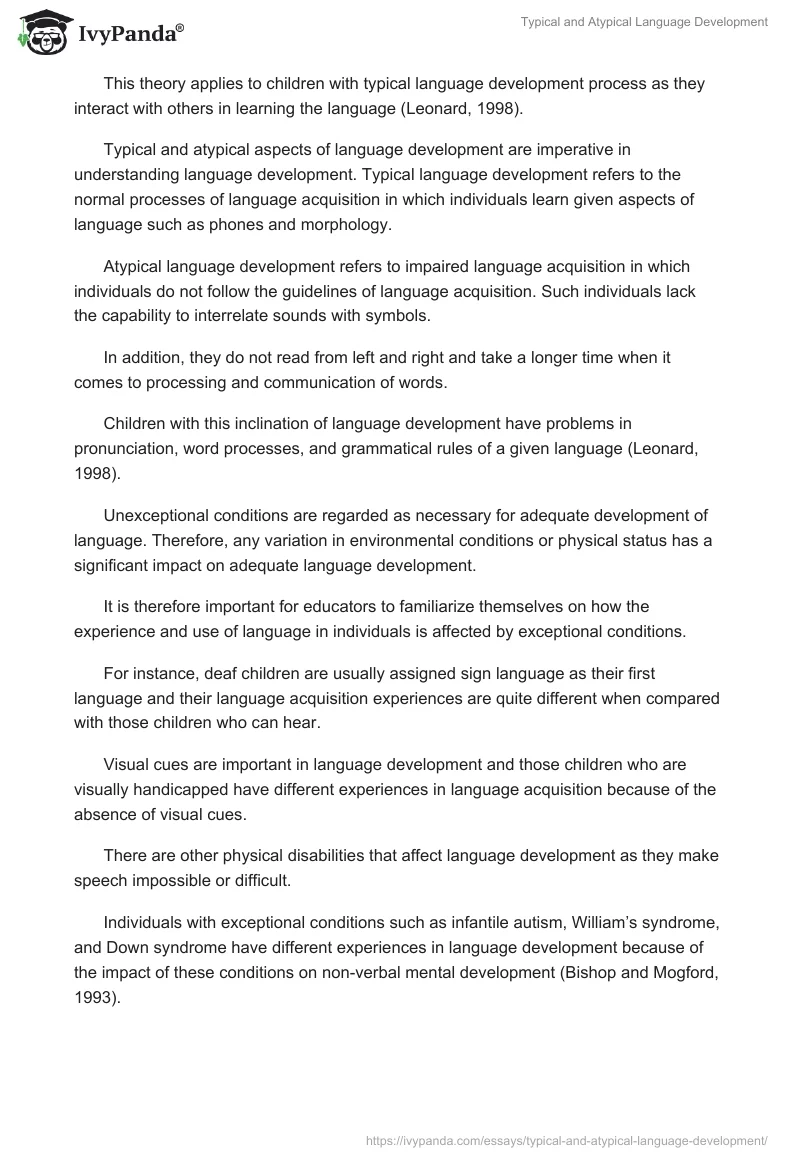Introduction
This essay describes language theory and development including typical and atypical language development.
The first part analyzes major theories that relate to language development and provides illustrations on how exceptional conditions can interrelate with people’s experience with and use of language.
In the second part, the essay describes how language and culture can interact with exceptionalities and provides examples on how educators can be sensitive to diversity.
Language theory and development
Explanations on the development of language are provided by learning, biological, and interactionist theories.
Among all the theories that relate to language development, the social learning theory by Vgostky and the theory by Chomsky are the most common.
The theory by Chomsky regards language acquisition to be inherent in human beings. It is more suitable to typical language acquisition where individuals do not need to be taught to follow grammar rules.
Instead, they are taught to naturally learn the language. This theory does not however apply to atypical language development where sensory and perceptive aspects of communication play a significant role in language acquisition.
Social learning theory emphasizes on the role of inherent desire in language acquisition. Even though the child may possess a language acquisition device, language acquisition is motivated by the inherent desire.
This theory applies to children with typical language development process as they interact with others in learning the language (Leonard, 1998).
Typical and atypical aspects of language development are imperative in understanding language development. Typical language development refers to the normal processes of language acquisition in which individuals learn given aspects of language such as phones and morphology.
Atypical language development refers to impaired language acquisition in which individuals do not follow the guidelines of language acquisition. Such individuals lack the capability to interrelate sounds with symbols.
In addition, they do not read from left and right and take a longer time when it comes to processing and communication of words.
Children with this inclination of language development have problems in pronunciation, word processes, and grammatical rules of a given language (Leonard, 1998).
Unexceptional conditions are regarded as necessary for adequate development of language. Therefore, any variation in environmental conditions or physical status has a significant impact on adequate language development.
It is therefore important for educators to familiarize themselves on how the experience and use of language in individuals is affected by exceptional conditions.
For instance, deaf children are usually assigned sign language as their first language and their language acquisition experiences are quite different when compared with those children who can hear.
Visual cues are important in language development and those children who are visually handicapped have different experiences in language acquisition because of the absence of visual cues.
There are other physical disabilities that affect language development as they make speech impossible or difficult.
Individuals with exceptional conditions such as infantile autism, William’s syndrome, and Down syndrome have different experiences in language development because of the impact of these conditions on non-verbal mental development (Bishop and Mogford, 1993).
Language and culture
Culture determines thoughts, processes, and words that exist in a given language. In addition, it provides words, memes and homophones that exist in language.
Therefore, it determines the language and symbols that people in that cultural setting will use as a representation of particular words and sounds (Budreau, 2009).
People within a given cultural construct communicate using the shared set of meanings. Language is therefore not only part of culture, but also one of the major aspects of culture (Mamlin, 2012).
There are exceptionalities in the interaction between language and culture and educators need to be susceptible to diversity issues.
Educators can achieve this through individualization of instructional strategies in order to promote positive learning results for learners from diverse cultures.
Moreover, they need be aware of values, beliefs, as well as traditions of various cultures that can impact interactions in the school environment. They also need to be active in seeking resources that can enhance their understanding on how language and culture interact with exceptional conditions of individuals.
Sensitivity to diversity issues can also be demonstrated through the creation of learning environments that foster cultural understanding while encouraging active engagement of learners.
This provides them with the foundation for individualizing instruction for learners from different cultures.
Outside the school environment, educators can collaborate with families and community agencies in order to address the needs of learners from different cultural backgrounds throughout schooling (Mamlin, 2012).
Conclusion
Typical and atypical aspects of language development are imperative in understanding theories of language development. In the development of language, exceptional conditions intermingle with the experience with and use of language in people.
There are interactions between language and culture with culture providing words, memes and homophones that exist in language.
On the other hand, language is regarded as one of the major aspects of culture. Educators need to be sensitive to diversity in order to promote positive learning for individuals from diverse cultures.
References
Bishop, D, & Mogford, K. (1993). Language development in exceptional circumstances. East Sussex: Psychology Press Ltd.
Budreau, D. (2009). A comparison of early literacy skills in children with specific language impairment and their typically developing peers. American Journal of Speech-Language Pathology, 8, 249-260.
Leonard, L.B. (1998). Children with specific language impairments. Massachusetts: MIT Press.
Mamlin, N. (2012). Preparing effective special education teachers. New York: The Guildford Press.


